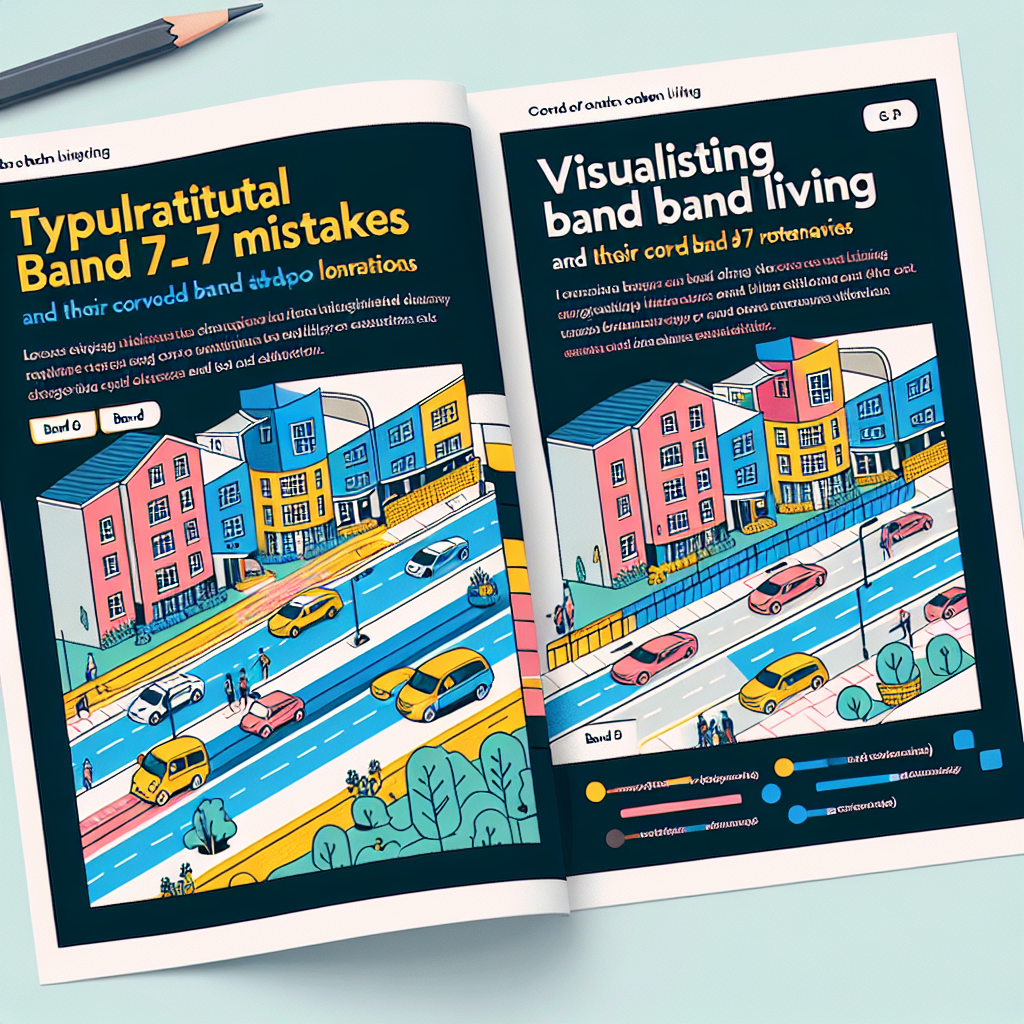Introduction
Urban life is a recurring theme in IELTS Writing Task 2 because exam writers love testing balanced argumentation and real-world examples. The benefits and drawbacks of city living touch on jobs, infrastructure, health, and sustainability—areas that allow you to show developed ideas, nuanced vocabulary, and strong coherence. In this guide, you will learn how to approach the topic effectively, study three full sample essays (Band 5-6, Band 6.5-7, Band 8-9), and understand exactly why each one receives its score. You’ll also get high-value vocabulary, high-scoring grammar patterns, and a practical checklist to improve your timing and quality.
Table Of Contents
Verified past questions on this topic include:
- IELTS Liz (Question Bank): “In many countries, more people are moving from rural areas to cities. Do the advantages of this trend outweigh the disadvantages?”
- IELTS-Blog.com (Recent exam topics): “Some people believe that living in big cities is becoming harder. What are the problems and what solutions can be implemented?”
- British Council LearnEnglish (sample topics): “Some people prefer to live in the city while others prefer the countryside. Discuss both views and give your opinion.”
For readers particularly interested in the human side of this topic, you can explore how urban pressures affect well-being in this related resource: To understand how mental health is shaped by dense urban environments, you can read The effects of urbanization on mental health.
 Urban city living benefits and drawbacks explained for IELTS Task 2
Urban city living benefits and drawbacks explained for IELTS Task 2
1. Question & Analysis
In many countries, more people are moving from rural areas to cities. Do the advantages of this trend outweigh the disadvantages?
- Question type and requirements:
- Outweigh question. You must present both sides, clearly state whether advantages or disadvantages are stronger, and justify your stance throughout.
- Key terms:
- “Advantages”: employment, education, healthcare, public transport, culture.
- “Disadvantages”: cost of living, overcrowding, pollution, social isolation.
- Common pitfalls:
- Listing without development (no examples or explanation).
- Unclear position; changing your view at the end.
- Off-topic focus (e.g., only discussing rural decline instead of city living).
- Strategic approach:
- Plan two main body paragraphs: one for advantages, one for disadvantages, then a clear evaluation.
- Use real examples relevant to your context (e.g., public transit in Bangkok, job hubs in Ho Chi Minh City).
- Use signposting to maintain cohesion: “While urban centres attract talent…, however, they also…”
This debate also links to how cities physically expand. If you want to understand a key planning issue behind urban growth, see The challenges of reducing urban sprawl for policy and planning perspectives.
2. Band 8-9 Sample Essay
Band 8-9 essays present a clear, consistent position, develop ideas logically with specific support, use a wide range of vocabulary accurately, and control complex grammar with very few errors.
Urban migration undoubtedly brings powerful advantages, most notably concentrated opportunities in employment, education, and healthcare. In many capitals, clusters of firms, universities, and hospitals create an ecosystem where talent, funding, and innovation feed off each other. As a result, ambitious graduates can secure internships, mid-career professionals can switch industries, and families can access specialists who are unavailable in remote regions. When viewed through this lens, cities accelerate social mobility and reduce service gaps.
Yet the costs are considerable. The most visible is the soaring price of housing, which forces newcomers into micro-apartments or long commutes. Overcrowded transport systems and endless congestion erode the very time that higher salaries are meant to buy. Less visible—but equally damaging—is the mental toll of noise, anonymity, and hyper-competition. If metropolises absorb residents faster than infrastructure expands, quality of life inevitably declines.
On balance, I contend that the advantages slightly outweigh the disadvantages, but only where city authorities govern proactively. Congestion pricing, integrated transit, and inclusionary zoning can keep mobility affordable and prevent displacement. Meanwhile, investment in urban parks and community centres can rebuild social cohesion, mitigating the isolation often reported by first-time arrivals. In short, city living is not inherently beneficial or harmful; outcomes hinge on policy and planning.
Therefore, while urbanisation can exacerbate inequality and environmental stress, its capacity to connect people to ideas, services, and careers remains unparalleled. With intelligent management, the urban dividend—innovation, diversity, and opportunity—can outweigh the undeniable drawbacks.
Band Score Analysis
| Criteria | Band | Justification |
|---|---|---|
| Task Response | 8.5 | Clear outweigh position maintained; both sides well-developed with concrete support and policy angle. Minor room for more data-driven examples. |
| Coherence & Cohesion | 8.5 | Logical sequencing; effective signposting; strong paragraphing; varied cohesive devices without overuse. |
| Lexical Resource | 8.5 | Wide topic-specific range (inclusionary zoning, social mobility, metropolises); precise collocations; no noticeable misuse. |
| Grammatical Range & Accuracy | 8.0 | Complex subordination and concise non-finite clauses; rare slips, mostly stylistic, not systemic. |
Why it excels:
- Sustained, nuanced position on “advantages outweigh disadvantages.”
- Specificity: references to policies (congestion pricing, zoning) not just generic ideas.
- Clear topic sentences highlighted to guide the reader.
- Strong cause–effect and conditional reasoning.
- Balanced evaluation with a practical framework (governance quality).
- Sophisticated but natural vocabulary fit for the topic.
This policy-oriented perspective pairs well with emerging trends in smart cities; readers curious about digital infrastructure can explore The role of technology in urban development to see how data and design improve urban life.
 Band 9 IELTS Task 2 city living essay structure and key ideas
Band 9 IELTS Task 2 city living essay structure and key ideas
3. Band 6.5-7 Sample Essay
At Band 6.5-7, arguments are relevant and explained, vocabulary is adequate to good with occasional errors, and grammar shows range despite some slips. Cohesion is generally clear, though not always elegant.
Many people move to cities because they want better opportunities. Urban areas usually offer more jobs, higher salaries, and top universities. For example, graduates from provincial towns often relocate to major cities to join international companies and attend evening professional courses. In addition, public services like hospitals and transport are concentrated in cities, so residents can reach specialists or commute efficiently compared with rural areas.
However, city life also creates serious pressure. The cost of rent takes a large portion of income, and commuting can still be exhausting due to traffic jams and crowded buses. Pollution is another disadvantage that affects everyone’s health, especially children and elderly people. Socially, many newcomers feel lonely even when they are surrounded by people; they work long hours and have little time to build strong relationships.
Overall, I believe the benefits slightly outweigh the drawbacks because access to education, stable careers, and reliable services can change a family’s future. Governments should reduce the negative effects by controlling housing prices, improving green public transport, and building more parks and community spaces. If these policies are implemented, city living will be more sustainable and humane for most residents.
Band Score Analysis
| Criteria | Band | Justification |
|---|---|---|
| Task Response | 7.0 | Clear stance; covers both sides with relevant examples; some ideas could be extended further. |
| Coherence & Cohesion | 7.0 | Logical progression with basic signposting; transitions are clear but sometimes repetitive. |
| Lexical Resource | 7.0 | Appropriate range for topic (pollution, commuters, sustainable); minor collocation stiffness. |
| Grammatical Range & Accuracy | 6.5 | Mix of complex and simple sentences; a few tense and article slips but meaning is clear. |
Direct comparison with Band 8-9:
- Thesis strength: Band 8-9 explicitly links outcome to governance; Band 7 is clear but less nuanced.
- Specificity: Band 8-9 cites concrete policies; Band 7 uses general policy categories.
- Cohesion: Band 8-9 uses varied, subtle transitions; Band 7 repeats simple connectors.
- Vocabulary: Band 8-9 chooses precise terms (inclusionary zoning); Band 7 uses broader words (controlling housing prices).
- Analysis depth: Band 8-9 shows cause–effect and conditional nuance; Band 7 presents solid but simpler reasoning.
4. Band 5-6 Sample Essay
Band 5-6 essays are understandable and address the task but may have limited development, noticeable grammar errors, and awkward vocabulary. Cohesion can be mechanical.
People choose cities because they think life is better there. There are more jobs and more schools, so young people can try to get success faster. Also hospitals and clinics are close, so if someone is sick they can go immediately. The entertainment is richer like cinemas and shopping malls, and many people enjoy this lifestyle after work.
On the other hand, city life have many problems. The price of apartments are too high, and young families cannot buy even a small place. Traffic is always stuck and make people feel tired when they go home. Additionally, there are too many pollutions from cars and factories, which is dangerous for health. People also feel alone because neighbors don’t communicate each other.
In my opinion the advantages are more than disadvantages, because people can improved their skill and career in the city. If the government build more subway and parks, the life quality will be better and people will be happier to stay.
Band Score Analysis
| Criteria | Band | Justification |
|---|---|---|
| Task Response | 6.0 | Addresses both sides and states an opinion; development is brief and examples are limited. |
| Coherence & Cohesion | 5.5 | Basic paragraphing; transitions are simple; some sentences feel disconnected. |
| Lexical Resource | 5.5 | Limited range; several word-choice errors (pollutions, life have); repetition of basic words. |
| Grammatical Range & Accuracy | 5.5 | Frequent subject–verb and countable/uncountable errors; some unclear phrases but overall understandable. |
Learning from Mistakes
| Mistake | Error Type | Correction | Explanation |
|---|---|---|---|
| city life have many problems | Subject–verb agreement | city life has many problems | “Life” is singular; singular subject takes “has.” |
| the price of apartments are too high | Agreement | the price of apartments is too high | “Price” is the subject; it is singular, so use “is.” |
| too many pollutions | Countable/uncountable | too much pollution | “Pollution” is uncountable. |
| don’t communicate each other | Collocation/grammar | don’t communicate with each other | Use “with each other” after “communicate.” |
| can improved their skill | Verb form/plural | can improve their skills | Modal + base verb; “skills” is plural. |
How to improve from Band 6 to 7:
- Extend ideas: add brief examples or data to support each point.
- Upgrade vocabulary: replace “problems” with “pressures,” “drawbacks,” or “downsides.”
- Accuracy first: fix common agreement and countability errors before adding complex grammar.
- Vary transitions: use “Nevertheless,” “By contrast,” “Consequently,” to avoid repetition.
For social and cultural dimensions—especially in large, diverse cities—some readers may find it useful to compare how tourism reshapes urban neighborhoods; a helpful primer is available here: For those interested in cultural dynamics, see impact of international tourism on local culture for parallels with city change.
 Improving IELTS Task 2 from Band 6 to 7 on city living
Improving IELTS Task 2 from Band 6 to 7 on city living
5. Essential Vocabulary
| Word/Phrase | Type | Pronunciation | Definition | Example and Collocations |
|---|---|---|---|---|
| urban migration | noun | /ˈɜːbən maɪˈɡreɪʃn/ | Movement from rural to urban areas | Urban migration intensifies housing demand; patterns, flows, drivers |
| social mobility | noun | /ˈsəʊʃl məʊˈbɪləti/ | Ability to move between social strata | Cities can boost social mobility; upward mobility |
| inclusionary zoning | noun | /ɪnˈkluːʒənˌɛri ˈzəʊnɪŋ/ | Housing policy requiring affordable units | Adopt inclusionary zoning to curb displacement |
| congestion pricing | noun | /kənˈdʒestʃən ˈpraɪsɪŋ/ | Charging drivers to reduce traffic | Implement congestion pricing in the CBD |
| cost of living | noun | /kɒst əv ˈlɪvɪŋ/ | Expenses required to maintain a standard of life | Rising cost of living; adjust for cost-of-living differences |
| public transit | noun | /ˈpʌblɪk ˈtrænzɪt/ | Public transport systems | Invest in reliable public transit networks |
| quality of life | noun | /ˈkwɒləti əv laɪf/ | General well-being | Improve residents’ quality of life |
| environmental footprint | noun | /ɪnˌvaɪrənˈmɛntl ˈfʊtprɪnt/ | Impact on the environment | Shrink the city’s environmental footprint |
| social cohesion | noun | /ˈsəʊʃl kəʊˈhiːʒn/ | Strength of relationships in a community | Parks can enhance social cohesion |
| affordable housing | noun | /əˈfɔːdəbl ˈhaʊzɪŋ/ | Low-cost homes for average earners | Expand affordable housing supply |
| by contrast | transition | /baɪ ˈkɒntrɑːst/ | Used to show difference | By contrast, rural areas lack specialists |
| consequently | transition | /ˈkɒnsɪkwəntli/ | As a result | Consequently, rents have surged |
| outweigh | verb | /ˌaʊtˈweɪ/ | Be greater in significance | The benefits outweigh the drawbacks |
| mitigate | verb | /ˈmɪtɪɡeɪt/ | Make less severe | Mitigate noise and air pollution |
| overcrowding | noun | /ˌəʊvəˈkraʊdɪŋ/ | Too many people in a space | Overcrowding strains infrastructure |
6. High-Scoring Sentence Structures
- Complex subordination
- Formula: Although/While + clause, main clause
- Example (from Band 8-9): “While urban centres attract talent, they also strain housing and transport.”
- Why it scores: Balances contrast concisely and shows control of complex clauses.
- Additional examples:
- Although rents are high, many graduates still relocate.
- While pollution has worsened, green transport offers hope.
- Common mistake: Using “despite” with a full clause without “the fact that.”
- Non-defining relative clauses
- Formula: Noun, which/whose + clause, main clause
- Example: “Public parks, which are often overlooked, rebuild social cohesion.”
- Why it scores: Adds precise, extra information smoothly.
- Additional:
- Mega-cities, which expand rapidly, need stricter zoning.
- Congestion pricing, which is controversial, can cut traffic.
- Mistake: Forgetting commas around non-defining clauses.
- Participle phrases
- Formula: -ing/-ed phrase, main clause
- Example: “Absorbing residents faster than infrastructure expands, cities risk declining livability.”
- Why: Compresses cause–effect elegantly.
- Additional:
- Driven by job prospects, many families relocate.
- Surrounded by strangers, newcomers feel isolated.
- Mistake: Dangling participles that do not modify the subject.
- Cleft sentences
- Formula: It is/was + X + that/who + clause
- Example: “It is proactive governance that determines whether benefits outweigh drawbacks.”
- Why: Emphasizes the key factor in your argument.
- Additional:
- It is affordable housing that keeps cities inclusive.
- It was the lack of planning that led to sprawl.
- Mistake: Overusing clefts can feel heavy.
- Advanced conditionals
- Formula: If + present, modal + base (with nuance)
- Example: “If authorities integrate land use and transit, residents will enjoy shorter commutes.”
- Why: Shows control of logic and prediction.
- Additional:
- If rents keep rising, young workers may leave.
- If green corridors expand, air quality should improve.
- Mistake: Mixing conditional verb forms inconsistently.
- Inversion for emphasis
- Formula: Only when/Not until + clause + auxiliary + subject + verb
- Example: “Only when housing, transit, and jobs align do cities deliver a net benefit.”
- Why: Sophisticated emphasis with accurate auxiliary placement.
- Additional:
- Not until costs fall do families feel secure.
- Rarely have cities faced such rapid growth.
- Mistake: Forgetting to invert the auxiliary and subject after the fronted phrase.
Urban sprawl is one consequence of weak planning; for readers exploring land-use strategies, a related deep dive is here: A detailed example is The challenges of reducing urban sprawl, which complements this section’s planning focus.
7. Self-Assessment Checklist
Before writing:
- Underline the task: outweigh vs discuss both vs problem-solution.
- Decide your position in one sentence.
- Plan two body paragraphs with one central idea each and an evaluation.
While writing:
- Start each paragraph with a clear topic sentence.
- Support every claim with a reason or example.
- Use varied transitions: by contrast, consequently, nevertheless.
After writing:
- Check word count (260–320 is safe).
- Fix easy errors: articles, agreement, countability.
- Ensure your conclusion clearly restates your stance.
Time management tips:
- 2–3 minutes to analyze and plan.
- 28–30 minutes to write.
- 2–4 minutes to check.
- If you are short on time, write a concise but complete conclusion.
City life is closely linked to how workplaces function in dense economies; for those interested in labor and inclusion, this piece offers useful context: For readers focused on equitable urban careers, see The benefits of inclusive workplace policies for how policy shapes daily life in cities.
Conclusion
The benefits and drawbacks of city living offer a rich arena to display balanced reasoning, precise vocabulary, and flexible grammar—key ingredients for a strong IELTS Writing Task 2 score. Your path to improvement is straightforward: master the question type, plan a clear stance, support each idea with specific examples, and use a range of accurate structures. With steady practice and targeted feedback, most learners can raise their writing by half a band in 6–8 weeks.
To deepen your knowledge, compare today’s topic with planning and mental health angles, and consider the role of technology and inclusive policies in shaping daily urban experiences. For readers who want to connect this discussion to smart-city innovation, you may also benefit from The role of technology in urban development. Finally, those researching sustainable growth will find a helpful parallel in The challenges of reducing urban sprawl.
Now it’s your turn: write your own response to the selected question, time yourself for 40 minutes, and post your essay for peer review. Consistent, focused practice is the surest way to progress from Band 6 to 7—and beyond.


